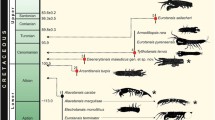Summary
Within the Clitellata the habit of brooding the eggs and offspring is known only in the Glossiphoniidae, suggesting that the habit probably arose de novo in that family. Within extant glossiphoniids, the degree of protection given to the offspring can be arranged in a continuous series of increasing complexity, which may approximate the phylogenetic development of the behaviour culminating with a well developed brood pouch in Marsupiobdella. Further analysis of this brooding behaviour may shed light on the relationships of the higher categories of the Hirudinea. Brooding, which may have been derived from the habit of ventilating newly laid cocoons, known in some erpobdellids, probably evolved as a mechanism for increased survival of the offspring by protecting the offspring from heavy predation.
Resume
Chez la Clitellata l'habitude de couver les oeufs et les petits n'est connue que chez la Glossiphoniidae, ce qui suggère que l'habitude s'est probablement produite de novo dans cette famille. Chez les glossiphoniids la mesure de protection accordée aux petits peut s'arranger dans une série continue de complexité croissante, qui peut se rapprocher de la développement phylogénétique de l'habitude, se culminent en une poche ventrale chez le Marsupiobdella. Une analyse de cette habitude de couver les oeufs et les petits pourrait peut-être éclairer les parentés des genres des hirudinées. Cette habitude, qui peut avoir développé de l'habitude de ventiler les cocons récemment pondus, connue chez quelques erpobdellids, a probablement évolvé comme un méchanisme qui produirait une plus grande survie chez les petits en les protégant de la prédation sévère.
Similar content being viewed by others
Literature
Barnes, R. D. - 1963 - Invertebrate Zoology. W. B. Saunders Co., Philadelphia. 632 pp.
Brumpt, E. - 1900 - Reproduction des Hirudinées. Mém. Soc. zool. France 13: 286–430.
Grassé, P. P., ed. - 1959 - Traité de Zoologie. Classes des Oligochètes et Hirudinées. 5(Part I): 224–713. (Masson et Cie, Paris).
Holt, P. C. - 1965 - The systematic position of the Branchiobdellidae (Annelida Clitellata). Syst. Zool. 14(1): 25–32.
Meyer, M. C. & Moore, J. P. - 1954 - Notes on Canadian leeches (Hirudinea), with the description of a new species. Wasmann J. Biol. 12(1): 63–96.
Moore, J. P. - 1958 - The leeches (Hirudinea) in the collection of the Natal Museum. Ann. Natal Mus. 14(2): 303–340.
Sawyer, R. T. - 1970 - Observations on the natural history and behavior of Erpobdella punctata (Annelida: Hirudinea). Amer. midl. Nat. 83(1): 65–80.
Sawyer, R. T. - in press - Freshwater leeches of Eastern United States, exclusive of the Piscicolidae, and a key to all North American freshwater species. III. Biol. Monogr.
Stephenson, J. - 1930 - The Oligochaeta. Oxford University Press, Oxford. 978 pp.
Author information
Authors and Affiliations
Rights and permissions
About this article
Cite this article
Sawyer, R.T. The phylogenetic development of brooding behaviour in the hirudinea. Hydrobiologia 37, 197–204 (1971). https://doi.org/10.1007/BF00015567
Received:
Issue Date:
DOI: https://doi.org/10.1007/BF00015567




